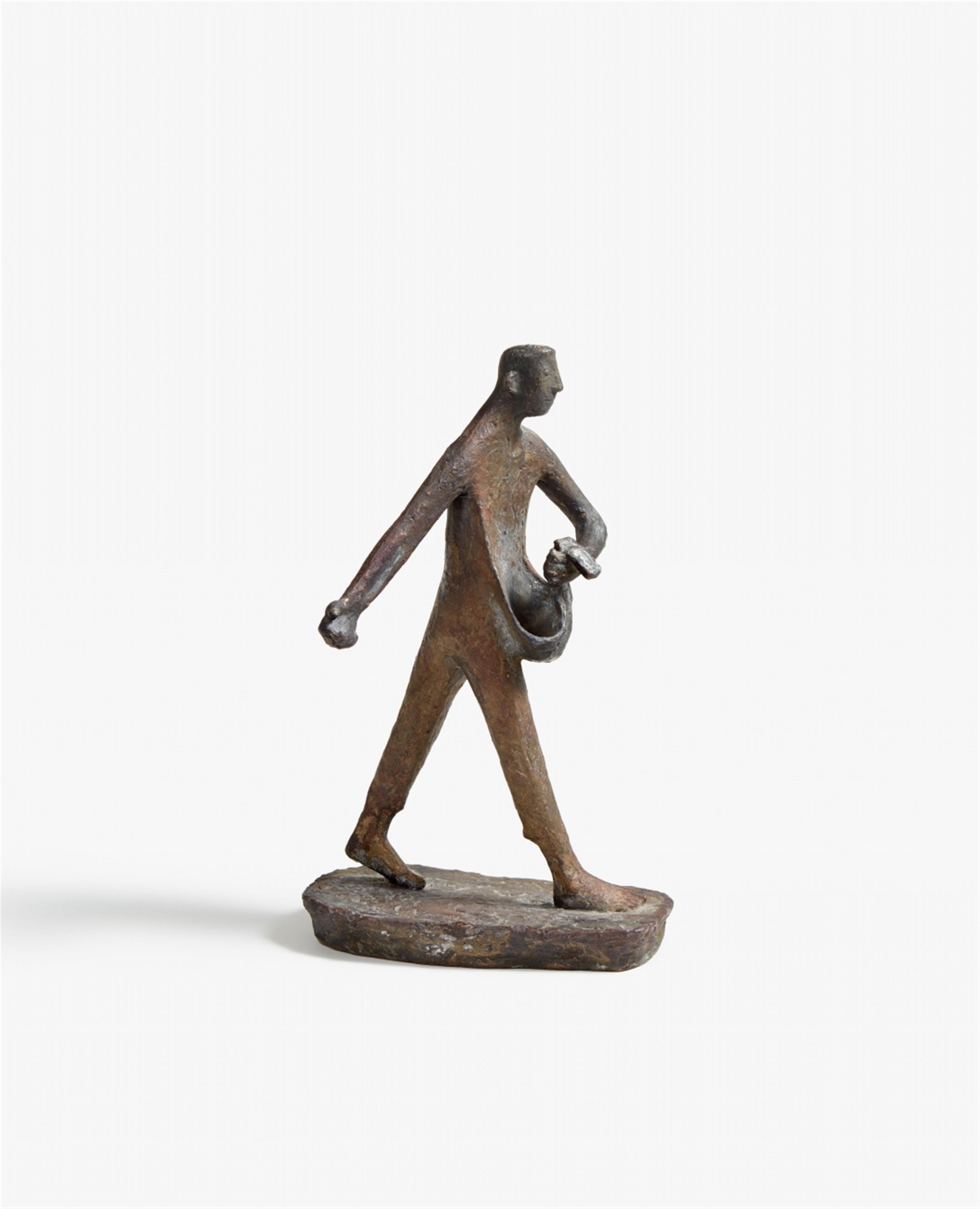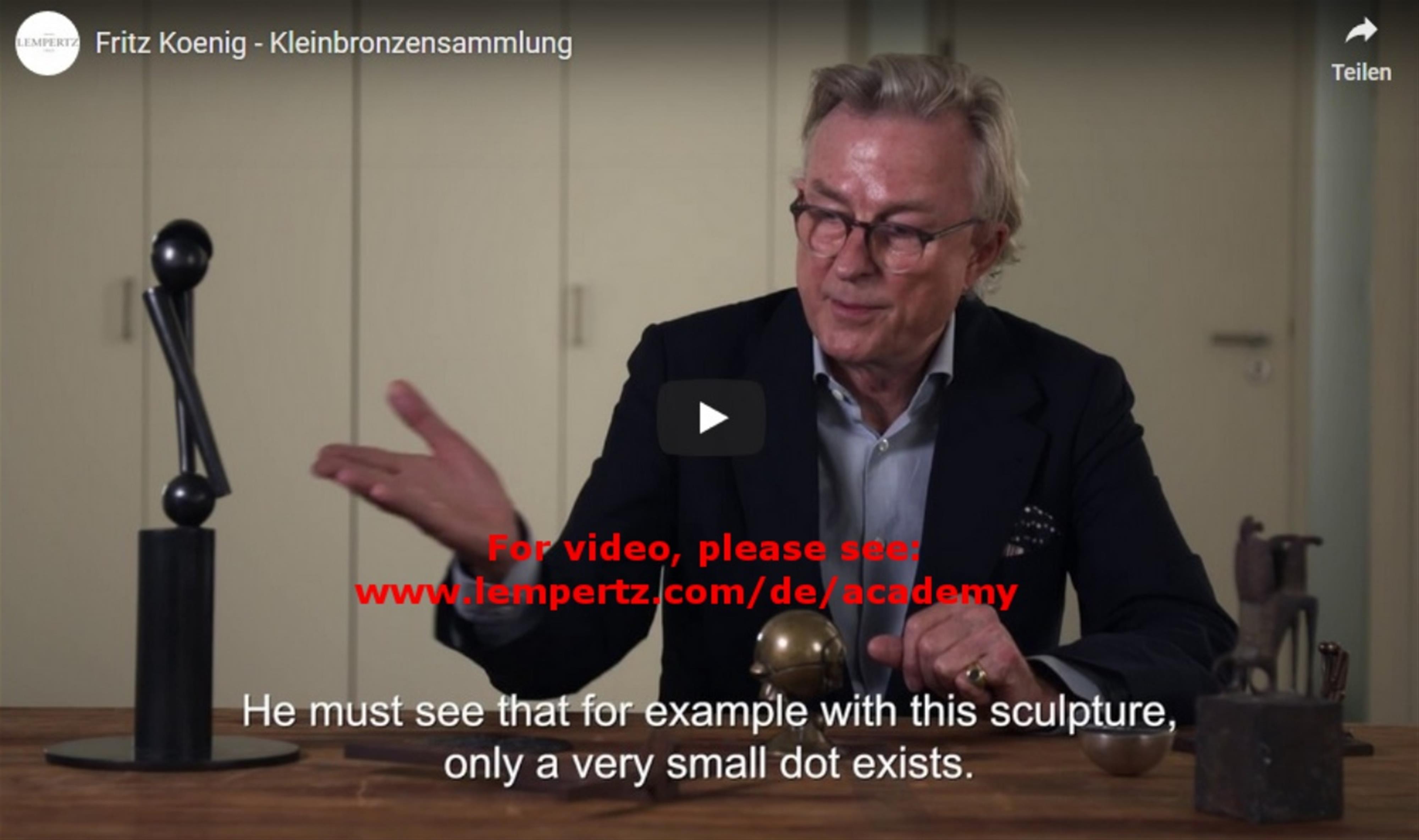Fritz Koenig
Kleiner Sämann
1947
Bronze with light brown patina. 28.4 x 14.6 x 17.3 cm. Monogrammed 'FK' (scratched). Recast.
A retrospective of the sculptor Fritz Koenig in Florence, in the city of the most ingenious and excellent Renaissance sculptors of exceptional standing such as Michelangelo, Donatello, Benvenuto Cellini, Giovanni Bologna gen. Giambologna. Hard to believe: Adolf von Hildebrandt's (1847-1921) 'great-great-grandson pupil' in the rooms of the Uffizi, in the Boboli Gardens, in the place where Hildebrandt once lived from 1874 onwards, studying the Italian Renaissance and pondering 'the problem of form in fine arts' and whose thoughts were published in a book in Strasbourg in 1893. The media celebrate Fritz Koenig, the artist who lived near Landshut until 2017, and his most extensive sculpture exhibition in the Medici city on the banks of the Arno River.
Fritz Koenig is one of the most respected sculptors of the post-war era, whose spiritual conditioning and individual style is rather allied to nature, pursuing tendencies of abstraction within the informal in a playful manner. Born in Wurzburg in 1924 and following active service, he begins his studies in 1946 in Munich under Anton Hiller, whose teacher Hermann Hahn in turn continues the tradition of austere forms of early classical antiquity attributed to Adolf von Hildebrandt. Reflecting on his experiences in the Wehrmacht, his themes circulate around the votive, the cross, and repeated forms of the epitaph. Not heroes of the near past, but horses in step, horses in the crowd, in the same way as Koenig encounters the animals in the Camargue, realising his early interest in horses with his own stud. The Quadriga, equestrian groups and other depictions with horses are the first sculptural group formulations that the artist, honoured by the Villa Massimo, processed into one of its signets from the mid-1950s onwards. Since 1961, Fritz Koenig has developed the area around the Ganselberg just outside the town of Landshut into a spacious studio where horses and his sculptures can develop together in future and where his art harmonises with nature.
In addition to 'free' sculpture, Fritz Koenig was repeatedly involved in the design of 'Kunst am Bau' [art for buildings], worked on church portals, tabernacles, and altar crosses for the cathedral of Wurzburg, created his first eye motifs and spherical shapes, and formed towering caryatids into equally large cross motifs. Koenig thus systematises his geometric-abstract paraphrases in the language of sculpture, with which he 'drives his basic figurations into the abstract in order to reintroduce them into the representational,' says Peter-Klaus Schuster.( Peter-Klaus Schuster, Die Grammatik der Formen. Zur Sprache der Skulpturen von Fritz Koenig, in: Exhib. cat.: Fritz Koenig. Skulptur und Zeichnung, Munich 1988, p.45).
This small, exquisite private collection of 17 small sculptures and Bozetti is a representative sample of the artist's oeuvre. 'Kleine Sämann' is exemplary for his first steps; 'Kleine Biga' signifies his first, strong and authentic appearance. With the spherical caryatids for New York, Koenig achieved international renown. Manifold votive panels, epitaphs, and the recurring examination of horses and the theme 'Zwei', secure the sculptor far-reaching recognition and a permanent position in the history of European sculpture.
From today's perspective, sculptures such as 'Kleine Sämann' are perhaps not typical of Fritz Koenig, but rather represent his first attempt at sculptural invention of form following the dark period of artistic and cultural dictatorship. A liberating moment with a view to the older generation of artists, who were also re-consolidating, with Ewald Mataré, Toni Stadler, Georg Kolbe, or Gerhard Marcks, and last but not least his teacher Anton Hiller. So it was a fundamental reorientation and reaction to the awakening of young sculptors. Koenig, however, is rather reserved; he processes abstract tendencies in stages. Moreover, they are always tied to nature, to the form, and the interaction of both.
Catalogue Raisonné
Clarenbach 16




